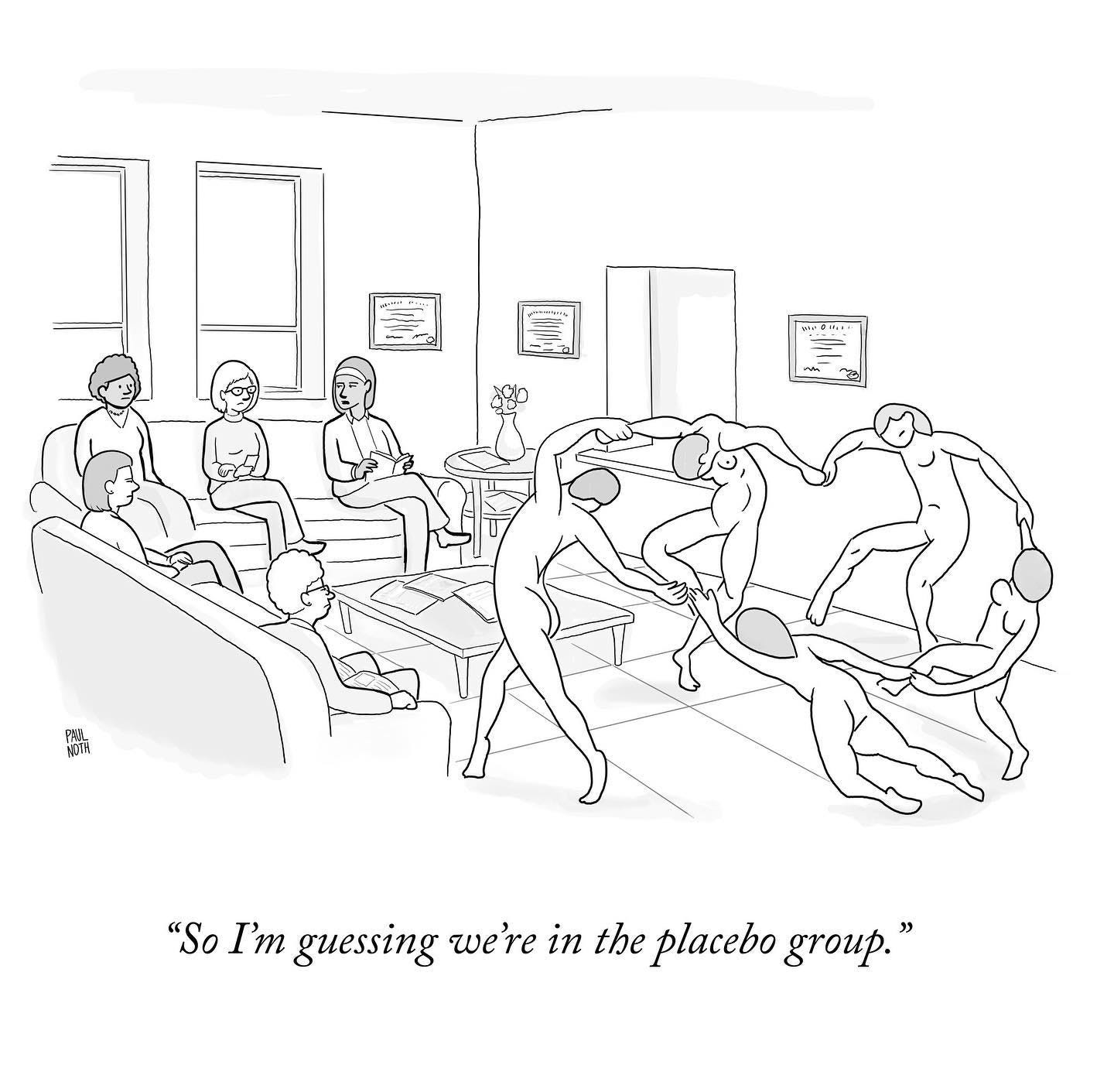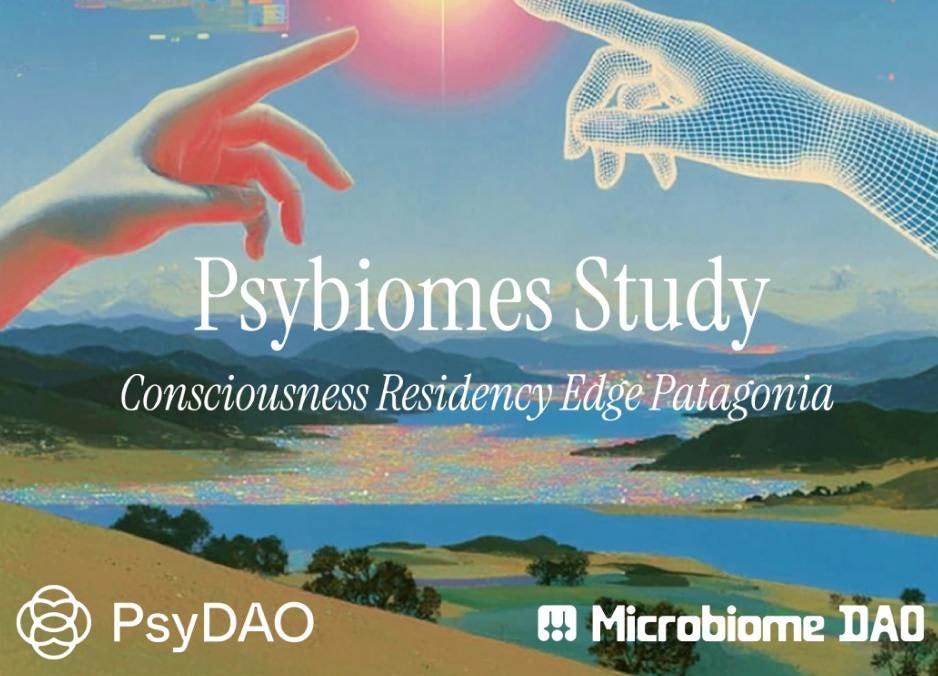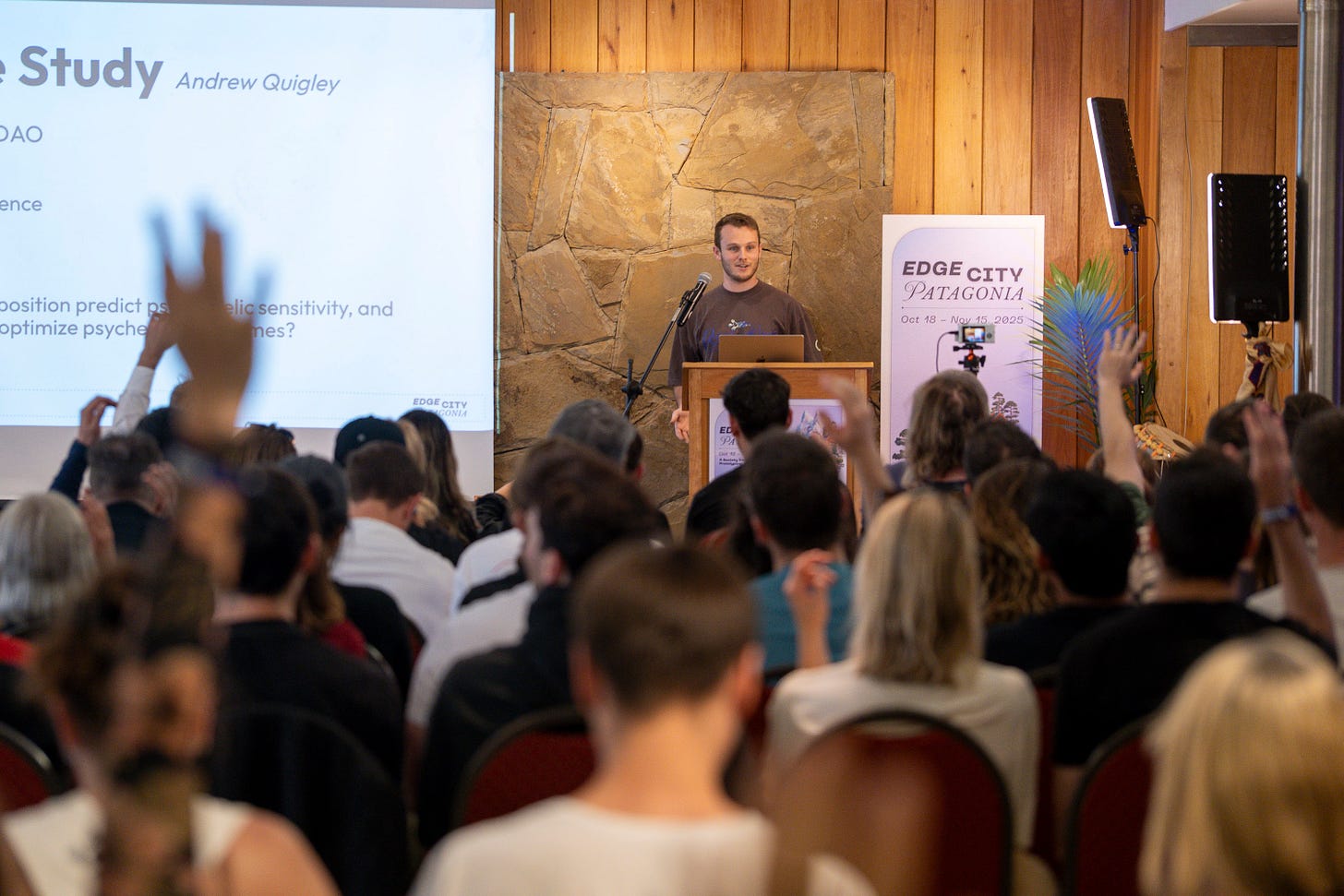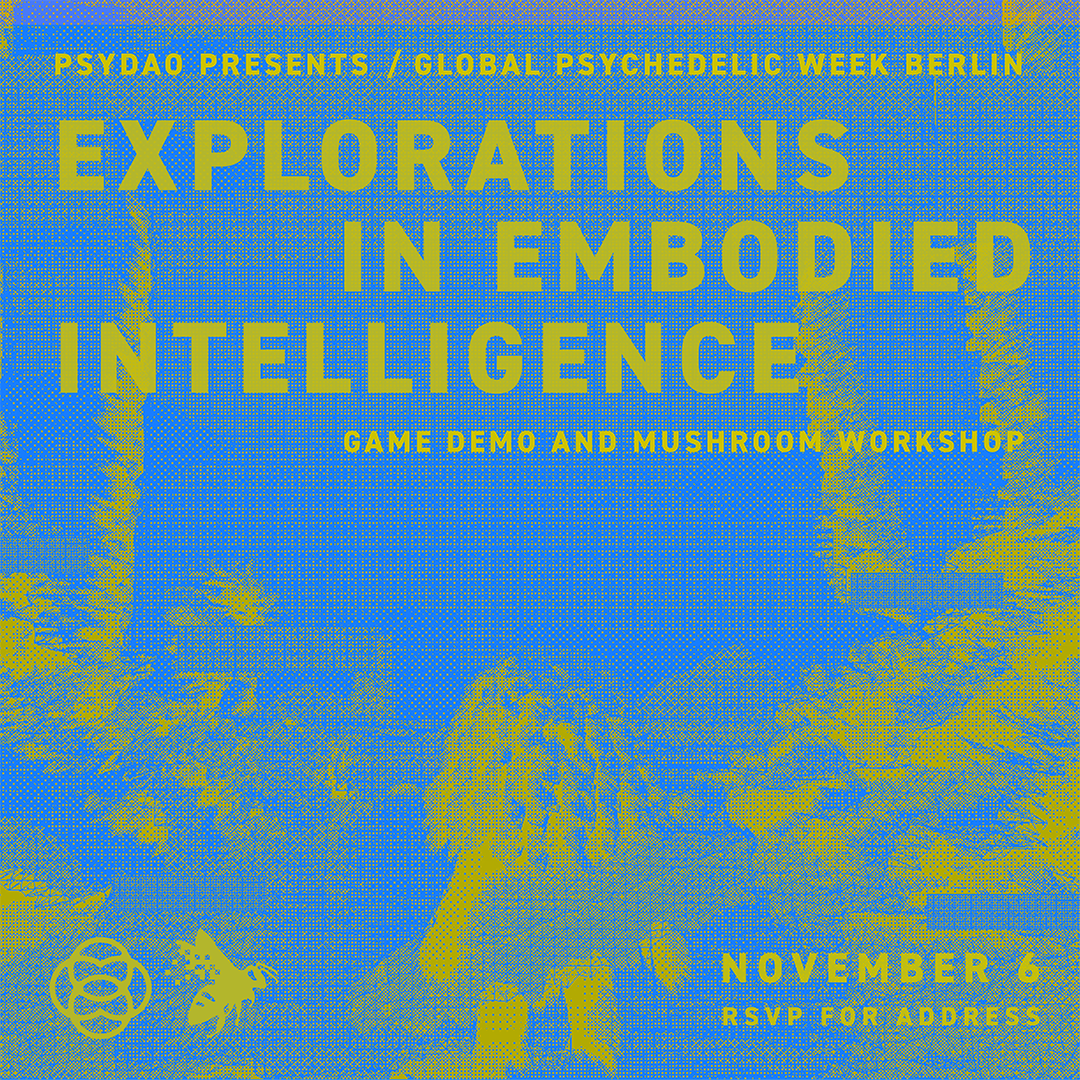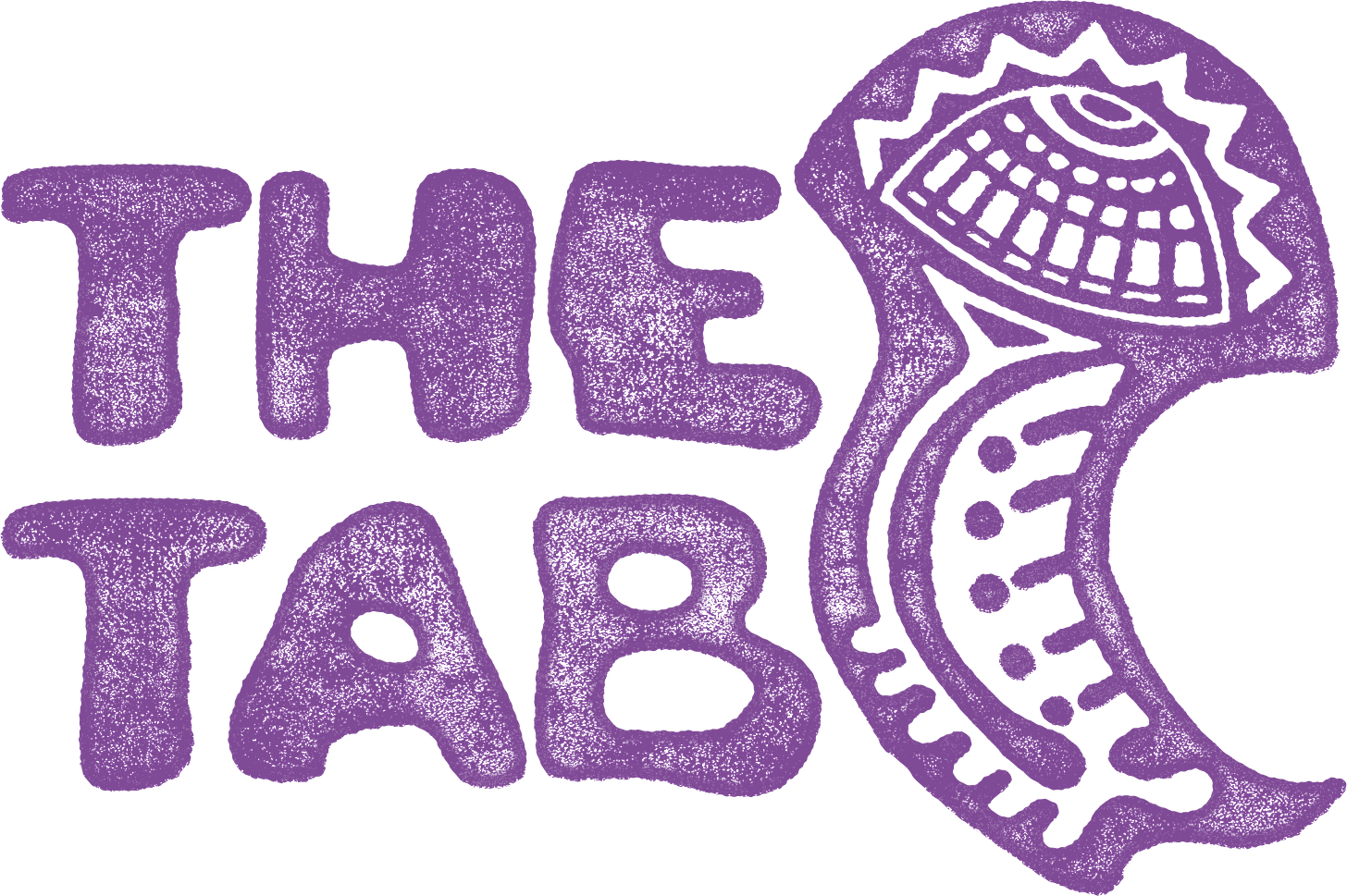Issue 005: What's the Heart of Psychedelic Treatment? The Drug? Or What Surrounds It?
A biotech expert on whether we should push for therapy along with our psychedelics. Plus: PsyDAO updates, global events, and medical attention for Argentinian soccer mishaps.
Hiya. We’re PsyDAO. We use tokens like Ethereum to subvert sus old systems of funding psychedelic science and art—for sanity and health. Our top three projects revolve around the DMT inside you: we built a cafe in the Amazon for a DMT-using tribe; are researching a novel psychedelic that acts on the same receptors as DMT; and are searching for the levers of the DMT inside you, with Andrew Gallimore.
This newsletter has research updates, pretty pictures, events, and music.
View in your browser for full effects (5 grams vs. a microdose, let us say).
First, an exclusive essay from a new contributor, Max DeRosnay, on…
Does Psychedelic Treatment Require Psychotherapy?
Are we talking about “molecule-first medicine”? Or “psychotherapy with a pharmacologic catalyst”?
Which comes first: the drug or the love?
Europe answers this question by categorizing and measuring each part individually. In America, MDMA-assisted therapy for PTSD bundled the therapy with the molly, and the whole shebang wasn’t approved.
Europe, unlike the U.S., tends to publish the yardsticks early. If you call the non-drug element “psychological support,” what exactly do you mean? Is it a safety measure, such as a sitter who keeps vitals in range, or is it therapy—structured, intentional, trained, with unconditional positive regard, and integral to outcomes? The distinction matters in Europe, because different authorities regulate them. The European Medicines Agency (EMA) has already folded psychedelics into its depression guidance, and the ask is refreshingly plain:
State your terms, specify what the drug is doing, what the “support” is doing, how each will be measured, and who is accountable for which part.
Let’s take a closer look at the two sides of the therapy-or-no argument:
Molecule-First vs. Psychotherapy-First
On one side, the “molecule-first” camp, associated with Dr. Guy Goodwin of Compass Pathways, posits that a high dose of psilocybin (or any psychedelic for that matter) can act as a treatment in its own right, with staff providing screening, preparation, safety and basic integration, but not psychotherapy proper.
The counter argument, proposed by Dr. Max Wolff, holds that psychedelic treatment is psychotherapy, since outcomes hinge on therapeutic alliance, preparation and integration. Dr. Wolff’s view is that stripping out set, setting and therapist doesn’t clarify the treatment, it simply changes it. In other words, let’s stop pretending we can strip these out and still recognise the treatment.
(You can read more about the debate here).
One recent proposal from Dr. Wolff tightens the logic—he imagines licensing the drug as a tool (think anaesthesia as an enabler of surgery, not a cure in itself), and letting professional bodies and health systems govern the psychotherapy the tool might make possible. In other words, regulators evaluate whether the compound reliably and safely induces the acute state, and then payers set the standards for the therapeutic work built on it.
The anti-medicalisation crowd may like what they hear from the “molecule-first” camp. Who needs a therapist to take psychedelics, you say? But remember, here we’re talking about the sickest patients, not someone taking three grams in their living room for the sake of it.
Rather, there’s a strong philosophical and a financial undertow at play. Philosophically, materialism offers a tidy promise that the mechanism sits in the receptor, the hallucinatory content is expendable, and the prize is isolating “drug effect” from “talk effect”, hence the chase for non-hallucinogenic routes (Delix Therapeutics, for example). Financially, therapist time is the biggest cost driver, so trimming or rebranding psychotherapy looks efficient.
However, the latest cost-effectiveness critique by Elliot Marseille and Jennifer Mitchell complicates that story. They argue Lykos compared against the wrong thing (placebo-therapy, not standard of care (SoC)) and assumed a $36,000 drug bill; model it against real-world comparators with a roughly $10,000 drug price and MDMA therapy becomes extremely cost-effective (potentially cost-saving) and even frees headroom to pay clinicians properly!
The practical takeaway, however, is that the pivot to “less therapy” is as much about unit economics and approval optics as it is about science. Europe has little patience for that dodge, with Health Technology Assessment bodies not asking “is it better than placebo?”, but instead, more pointedly, they ask “is it better than what we already have, at a price the system can bear?” That means standard of care comparators, total healthcare utilisation (not PTSD costs in a silo), and a bundle price that buys enough qualified human time to keep patients safe.
The counterpoint, argued forcefully in European forums and the clinical literature, is that outcomes depend on the container; what patients experience, with whom, and how it’s held. Strip those layers apart and you blunt the treatment, ending up in regulatory limbo. The MDMA no-votes didn’t punish soft methods so much as fuzzy labelling.
If you want to control cost without hollowing out care, the levers are obvious; group formats, therapist-fidelity tooling, and shared outcome registries, paired with honest, all-in pricing of the bundle you’re actually delivering.
The FDA zeroed in on functional unblinding—meaning: it’s hard to hide whether someone got a placebo or a psychedelic. And the FDA pressed on how sponsors would separate drug from psychotherapy, pointing to designs and controls that could parse each component, even after pivotal trials had run. Sponsors got the message and are redesigning trials to isolate the molecule with drug-only arms (see MM120), excluding concurrent psychotherapy, active placebos, and formal expectancy measures. It may be tidier for regulators, it may be more lucrative for shareholders, but it may or may not be safer or more effective for patients. Europe’s instinct is to keep the bundle intact, then split responsibilities and measure each part. Less cinematic than a last minute showdown, but sturdier theatre… (EMA Workshop)
So what should serious builders do now? Name your bundle. If it’s drug + psychotherapy, design and power for the bundle. If it’s drug + safety support, prove it. Expectancy and blinding assessments, active controls where feasible, and therapist-behaviour standards so “support” isn’t stealth therapy. Then price the bundle the way payers think, i.e, against standard of care, with full system costs, and with enough headroom to recruit, train, and supervise clinicians. Europe will reward that clarity sooner while U.S. reviewers increasingly demand it. Either way, ambiguity is no longer a strategy, it’s in fact a total liability.
Moral of the story? Clean methods are the best insurance against panic. And if we have to choose, choose what serves patients; rigorous bundles that are safe and effective, even if they’re messier to regulate or less convenient for shareholders.
So where can PsyDAO help with all of this?
Fund the connective tissue. Back shared trial modules for expectancy/blinding and therapist-fidelity so results are comparable across sites. Co-fund registries that track outcomes and adverse events beyond the session. Support training and supervision frameworks that align with what EMA/HTA bodies will actually accept. And, crucially, model pricing scenarios that make clinical and economic sense in public systems. (See the end of the blog for references.)
$eDMT: Research on “the DMT Inside” moves forward
At the University of Florida, Dr. Chris McCurdy’s lab is busy putting a magnifying glass to the little levers inside the body that make DMT. DMT is the world’s craziest psychedelic and, oddly, the one we all carry in our bodies. End goal: create a medicine to Get High on Our Own Supply of DMT—to protect brain cells, heal depression, and lead to happier, easier lives.
PsyDAO put $100,000 into the research. It’s a clear example of how the Ethereum blockchain, which can seem so abstract, can change the world. Get the eDMT token here.
The project was conceived by renowned DMT expert Dr. Andrew Gallimore. We expect preliminary results within a month or two. Read more about our project here.
We’re also fielding funding requests from others in the endogenous DMT world. We’re stoked on research into how darkness and breathwork might boost endo-DMT.
PsyDAO IRL
Patagonia Mushie Tummies
PsyDAO emissaries are infiltrating Argentina for one of the most bonkers crypto events in the world, EdgeCity Patagonia. PsyDAO team member Aqueou5 is at the event, a pop-up town on the brink of the ocean. It’s full of Ethereum and Bitcoin developers and devotees. We’re doing a study with an Ethereum org called MicrobiomeDAO to explore how the gut microbiome affects psychedelic sensitivity, and how dietary interventions optimize psychedelic outcomes. The goal is to mint a “PsyBiome IPT” from the data, to connect happy heads and tummies.
PsyDAO will also do:
An Immersive Exhibit on our Amazonian art and botanicals project, KenéLife.
Presentation on our endogenous DMT research by science lead Dr. TyQu, PhD.
Talks and panels on funding psychedelic and culture, and film screenings.
Medical interventions for Aqeuou5, who broke a toe playing Argentinians in soccer.
Grounding exercises so we don’t fall off the edge of the world.
If you’re in Patagonia—and we assume you are—find more info here.
Berlin Calling: AI game and Mushroom Workshop
Then, there’s Global Psychedelic Week. Happening, well, globally. Our European team, Brittney Scott and Beata, are hosting an event Nov. 6 in Berlin called Explorations in Embodied Intelligence. They’ll celebrate the launch and demo of our new psychedelic knowledge graph game, Graphsurfer. And they’ll run a special chocolate workshop led by Yun of art collective Psy Earth and author of ‘The Future is Fungi’.
Bist du in Europa? RSVP for the event here.
Nov. 7, PsyDAO curates Sonic Breath—a 90-minute immersive journey that weaves together breathwork, movement, and sound healing to soothe your nervous system and open your heart.
Mouth breathers RSVP here.
RoundTrip
We’ve been hosting regular X Spaces with scientists in our orbit. They’re called RoundTrip. Follow PsyDAO’s main Twitter account for Monday and Friday shows.
New Plant Medicine Discovery
Our favorite Amazon ethnobotanical from the Shipibo people, KeneWaste, has been rigorously analyzed at a top-notch psychedelic-testing lab in Colorado. The tests showed a new psychedelic contained therin. We’ll confirm its presence with scientific rigor. KeneWaste is a great perfume, Shipibos say, for productivity and love. Any monetary or IP benefits will be shared with the Shipibo through on-chain, auditable Ethereum smart contracts. Export licenses are being acquired to ship around the world. Pre-order the perfume at the KeneLife store.
Music Therapy
“Zak Krevitt is a multimedia multi-hypenate from LA who has moved further and further east over the years as the US slides further into fascism. He wants you to shake your ass, spiritually speaking, and his dying dog wants you to know it’s OK to forgive yourself for what you did last weekend.” -Zak
Zak curated the playlist to be listened to in the order it’s arranged in full. Listen on Soundcloud







